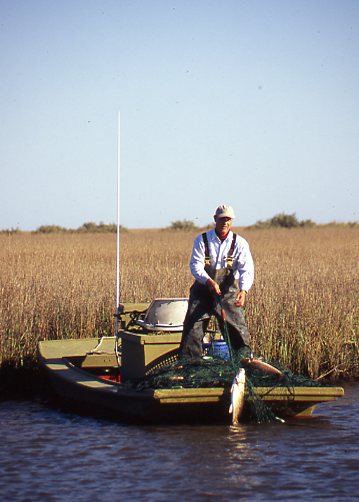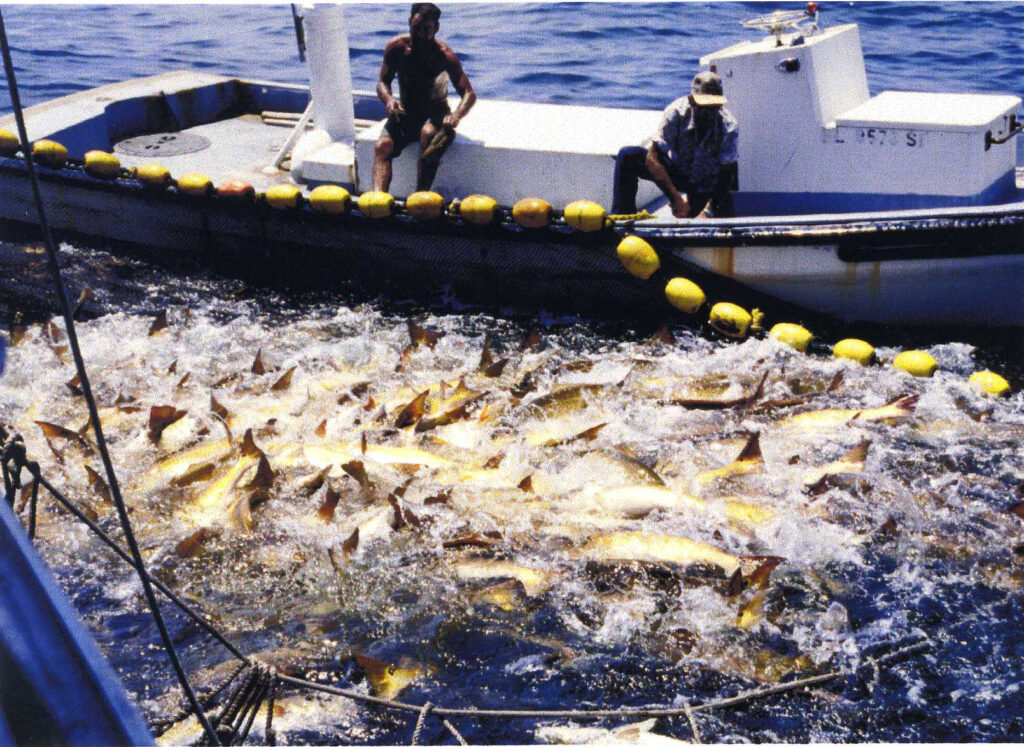A lie can travel halfway around the world while the truth is putting on its shoes.
― Mark Twain
Online encyclopedia Wikipedia says, “In the early 1980s, the chef Paul Prudhomme made his dish of Cajun-style blackened redfish (red drum) popular. His seasoning was then sold commercially and the dish became so popular that redfish were overfished to the point of near extinction.” The statement is footnoted, “citation needed.”
Don’t hold your breath.
No one but Wikipedia ever implied that the Gulf of Mexico’s redfish were “overfished to the point of near extinction” because Chef Paul sold a lot of his seasoning “commercially.” Over the years, a whole lot of people, in a whole lot of different publications, have repeated some variation of the claim that, “Chef Paul blackened a redfish and commercial fishermen fished the species to the brink of extinction.”
None of them cited a credible source either.
The book “Missing Redfish” is a history of the red drum’s management in the Gulf of Mexico. Obviously, a good work of history should detail the actual events that occurred during a particular period, and “Missing Redfish” does cover the management highlights of this contested species from the late 1970s into the 21st century.
But history’s not a closed book, there’s always more to learn, and the lessons from history can not only teach us more about the past but the present and maybe even the future as well.
What Happened?



According to the LSU AgCenter’s Research and Cooperative Extension Service, “If the fish in these year-classes were overharvested, it occurred in inshore waters by inshore recreational and commercial fishermen. This meant that the damage was done by 1981. The ‘blackened redfish craze,’ also commonly believed to have caused the problem, didn’t really take off until 1983. During the 1980 to 1988 period, commercial fishermen took an average of 28% of the redfish and recreational fishermen harvested 72%.”
[“Missing Redfish” readers may recall this quote from the first edition in 2017. More recent information indicates that the recreational share of the catch in the 1980s was even greater than biologists thought: In 2018, the National Marine Fisheries Service abandoned its old landline-based method of surveying anglers and replaced it with an updated “Fishing Effort Survey” that agency statisticians consider to be much more accurate. When they reassessed the recreational fishery’s historical landings with the new methodology, they concluded that for-hire and private recreational fishermen had been catching roughly three to five times as many red drum as had previously been reported!]
In short, the offshore purse seine fishery took off in response to the demand created by “blackened redfish.” Research triggered by that new federal fishery uncovered a void in the offshore population—the “missing fish.” The fish had begun to go missing years before “blackened redfish,” perhaps for environmental reasons, and/or because management in the states hadn’t kept up with the gradual increase of local commercial fishermen and the tsunami of sport-fishing Baby Boomers.
Still, egg production by the brood stock never fell to a level that jeopardized the recruitment of young fish, as evidenced by the rapid recovery that was observed inshore as soon as the states restricted their fisheries. The species was never “endangered,” on the “brink of extinction,” or even close. Yet every pop account of the fishery entails some variation of, “Chef Paul blackened a redfish and commercial fishermen fished the species into oblivion.”
What happened to the recreational fishermen?
The repetition of false claims or beliefs is how myth arises, and beliefs and myths are all that many people want or need. The problem is that when your actions are based on myth instead of truth you can end up just going around in circles.
For those who’d rather advance, “Missing Redfish” offers plenty of lessons, some specific to the fishery, some more far ranging:
LESSONS
- The population of offshore “bull” redfish should be sampled or, better yet, monitored on an ongoing basis.
Before commercial fishermen began to fish the bulls in the 1980s, each state blindly fished its own slice of the overall population. Research prompted by the new offshore fishery provided the overview that found overfishing to be occurring within the states.
Managers responded by initiating cutbacks before the population was seriously depleted.
That fact alone seems ample reason to keep tabs on the offshore population. Yet, as we’ve seen in “Missing Redfish,” federal managers drag their feet and indeed may never conduct another stock assessment. Instead, they indirectly assess the offshore population’s health by tracking the total annual catch from state waters.
What could possibly go wrong?
In Louisiana alone, between 1981 and 2013, the number of fishing trips by saltwater recreational anglers doubled in number, from 5.4 million to more than 10.7 million, while the sportsmen’s catch of red drum quadrupled, from 6.8 million pounds to nearly 25 million pounds, not including the additional regulatory discards that died after release. (Since 1989, the state’s commercial fishermen were prohibited from landing any reds.)
During the same period, recreational landings of the state’s equally popular spotted seatrout more than doubled, from 7.3 million pounds in 1981 to 16.8 million pounds in 2013. A 2019 stock assessment by the Louisiana Department of Wildlife and Fisheries found that the species had been overfished since 2014. (At the same time, commercial fishermen—limited to rods and reels—were landing an average of about 2,500 pounds of trout per year. Not a typo!)
- The brood stock isn’t sacred.
The best stock assessments of the red drum in the Gulf utilized data collected from the offshore commercial fishery. Because the offshore breeders are discrete from the immature inshore fish, many folks think of them as sacred. They’re not. In fact, say biologists, the fishery could be managed sustainably by harvesting a surplus of the brood stock only and leaving the small inshore fish alone.
- The 1976 Magnuson Act, which guides how federal fisheries are to be managed, was a remarkable piece of legislation.
Like the framers of the Constitution, Magnuson’s authors seemingly anticipated every possible problem that could arise.
As the offshore commercial fishery expanded, the regional management council set to work on a management plan. Since it typically takes a few years to collect enough data on a new fishery to design a plan, the House of Representatives called for President Ronald Reagan’s Secretary of Commerce, Malcolm Baldrige, to invoke a never-before-used provision of the Magnuson Act; it empowered him to put an interim management plan in place if the appropriate fishery management council didn’t have a plan.
In the meantime, “in order to safeguard the red drum resource from possible over-exploitation,” the act enabled Baldrige to issue emergency rules that soon brought the fishery to a halt.
- Once they’re in and you’re out, it’s hard to get back in. When a fishery declines to the point that cutbacks are needed, they should be applied equitably to all user groups.
Federal fishery law says as much, and in federal waters managers did shut down red drum fishing by both sport and commercial fishermen.
Other examples of equitable federal management include the striped bass on the Atlantic Coast and the red snapper in the Gulf: When stripers were depleted in the 1970s and 1980s, federal managers shut down all fishing; when the population rebuilt to where it could again sustain a harvest, most of the states reopened their fisheries to all of the users. The popular red snapper was also found to have been overfished in the 1980s. (Yes, another fishery with an outsized recreational component overfished in the 1970s and 1980s.) Federal managers severely reduced the harvest of all three sectors—seafood producers, private recreational anglers, and tourist-dependent charter-boat captains—who all shared in the pain and, later, the gain as the population rebuilt.
State-level management is more capricious. When a timeout in inshore redfishing was called for, politically connected recreational anglers—led by the special interest Coastal Conservation Association—convinced legislators in Louisiana and Florida to banish the food producers from the fishery and allow themselves to continue fishing.
(By the late 1980s, “conservationists” in Texas and Alabama had already won exclusive access to the species, leaving Mississippi as the only American state on the Gulf of Mexico with management equitable enough to maintain both a sport and commercial red drum fishery.)
- Sharing is the best way to sustain a fishery: The two-party system is all about checks and balances.
Like the Republicans and Democrats, the sport and commercial interests keep a check on each other.
Sharing also keeps the redfish relevant to everyone rather than just the recreational subset. On the other hand, as experienced on the Gulf, when consumers lose access to their wild fish, a meaningful link to the natural world is severed and the cultural significance of that species is diminished.
When it comes to stewardship, maximizing a fish’s value to society naturally maximizes not only the incentive to sustain its abundance but the resources that are available to do so.
- Scapegoating of commercial users by recreational users isn’t unique to the red drum, or even fisheries in general—it’s a distinctly American tradition of wildlife management that has rarely resulted in sustainable abundance.
Ask most any recreational fisherman on the Gulf Coast what happened to the redfish, and he’ll recite, “Paul Prudhomme invented blacked redfish, commercial fishermen nearly wiped out the reds, and we saved them. Just look how they came back after we banned the sale of redfish and took away the commercial fishermen’s nets.”
We know, of course, that at the same time politicians excluded commercial fishermen from the fishery, the multitude of recreational fishermen was also severely restricted, which left millions more fish in the water.
“History is almost always written by the victors and conquerors and gives their view,” said Nehru. And when histories are written by the “victors and conquerors” they may not include all the views and facts that add up to the truth. Yet it doesn’t matter how many people get together to believe the same thing or tell the same fib, facts are facts, truth is truth and numbers don’t lie.
So, now that we’ve seen how myth and falsehoods can prevail even while many of the contemporary participants are still around, what does that say about our perception of the wildlife declines that occurred in bygone times?
Were both the abundance and the declines exaggerated to make a more satisfying story? Did environmental factors contribute to those declines or were the downturns attributable solely to “commercial” or “market” fishermen, trappers or hunters, as the histories of the “victors and conquerors” typically explain? Maybe there were other harvesters as well, folks killing either for subsistence or sport?
If so, and if your management target is sustained abundance, rather than simply “winning,” your next question must be, “What are the numbers on that?”
